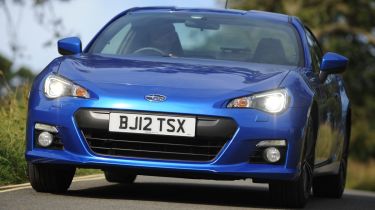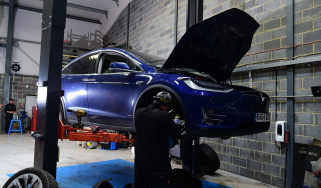Subaru BRZ
Newcomer takes back-to-basics approach to behind-wheel thrills
While there are subtle differences between the BRZ and GT 86 on the road, it’s difficult to separate them, so the Subaru deserves as much praise as the much-vaunted Toyota. The aggressive and simple styling, absorbing driving dynamics and greater practicality give it the edge in this test, helping to justify its higher price. We can’t wait for a hot BRZ STi to demonstrate what this great chassis can really do.
History can be a blessing or a curse. So while Toyota named its GT 86 after the legendary eighties AE86 Corolla, Subaru has given its version of the car a mission statement.
The BRZ badge stands for ‘Boxer Rear-drive Zenith’ and refers to the project’s engine, chassis layout and aspirations. Everything about the BRZ has been designed with the thrill of driving in mind – and that includes the striking exterior styling. Unlike most coupes, the Subaru isn’t beautiful in the conventional sense, but the low nose, bulging wheelarches and wide track give it a very purposeful and dynamic stance.
Subtle changes to the bumper and fake vents on the front wings are the only real differences between the BRZ and the GT 86, but without the Toyota’s gaudy badges and finished in Subaru’s unique WR Blue Mica paint, the BRZ looks cleaner and simpler than its eye-catching sister model.
Used - available now

2022 MG
HS
26,343 milesAutomaticPetrol1.5L
Cash £15,978
2020 Renault
Captur
24,675 milesManualPetrol1.0L
Cash £11,803
2024 Kia
Niro
20,349 milesAutomaticPetrol1.6L
Cash £19,848
2024 Cupra
Formentor
25,379 milesManualPetrol1.5L
Cash £18,600All versions come with the same black and silver 17-inch alloys (which are designed to help channel cool air to the brakes), while the wide twin exhausts and rear diffuser are also standard. Despite being 220mm longer and 55mm wider than the MX-5, the BRZ is a lot more streamlined – its aerodynamic shape creates almost as little drag as the slippery and highly efficient Toyota Prius.
But that’s where any similarity between the hybrid and BRZ ends. Step inside the Subaru and you’re greeted with a cabin that puts the driver first. The seats are mounted lower than the Mazda’s and provide excellent support, the drilled alloy pedals are nicely positioned and the wheel adjusts for reach and height.
The top-spec SE Lux model in our pictures has leather and Alcantara trim, but the base SE that we tested makes do with cloth seats – although even this version gets climate and cruise control, keyless entry and start, plus USB and auxiliary audio ports as standard.
Buyers expecting a luxurious cabin will be disappointed, though. While there’s a decent amount of kit, the hard grey plastics and mismatched digital displays mean the BRZ feels really spartan inside – even compared to the outdated MX-5.
Still, the larger dimensions give the four-seater Subaru a big advantage over the Mazda when it comes to everyday practicality. Deep door pockets and a wide storage tray in the centre console mean that any loose items are easily secured.
The 243-litre boot is just about spacious enough to carry a pair of suitcases, and with the rear seats folded down flat, this compact coupe can swallow a very impressive 1,270 litres of luggage.
This surprising amount of flexibility has done nothing to blunt the BRZ’s handling, though. Subaru’s engineers have spent years honing the design to achieve near-perfect 53:47 front-to-rear weight distribution, and the 2.0-litre boxer engine is mounted as low down as possible in the chassis to ensure the BRZ stays planted to the road in corners.
All that hard work has paid off, too, as the Subaru responds instantly to steering inputs from the driver and body roll is virtually non-existent. Yet the ride is also supple enough to remain composed on bumpy roads – unlike the bouncy Mazda.
The engine gets progressively louder as you approach the 7,000rpm red line, and with a 39bhp power advantage over the MX-5, the BRZ was quicker in our track tests. It narrowly beat its rival from 0-60mph, in a time of 7.1 seconds, but in-gear acceleration was over a second quicker.
With the two-stage stability control system turned off, the Subaru’s playful handling is a joy. Plus, it feels more stable on the road than both its GT 86 cousin and the Mazda, which inspires confidence in the driver.
Still, not everyone will like the old-school approach, and although it’s the first Subaru with direct injection, it returned only 33.1mpg and emits a relatively high 181g/km of CO2.
Subaru’s comprehensive ‘Everything Taken Care Of’ aftersales package does take some of the sting out of the resulting high running costs, though. It includes dent and scratch repair, a full annual valet, collection and delivery from each service and even a monthly wash – all free of charge.
So will this be enough to tip the scales in the newcomer’s favour, or can the Mazda MX-5 show there’s life in the old dog yet?







